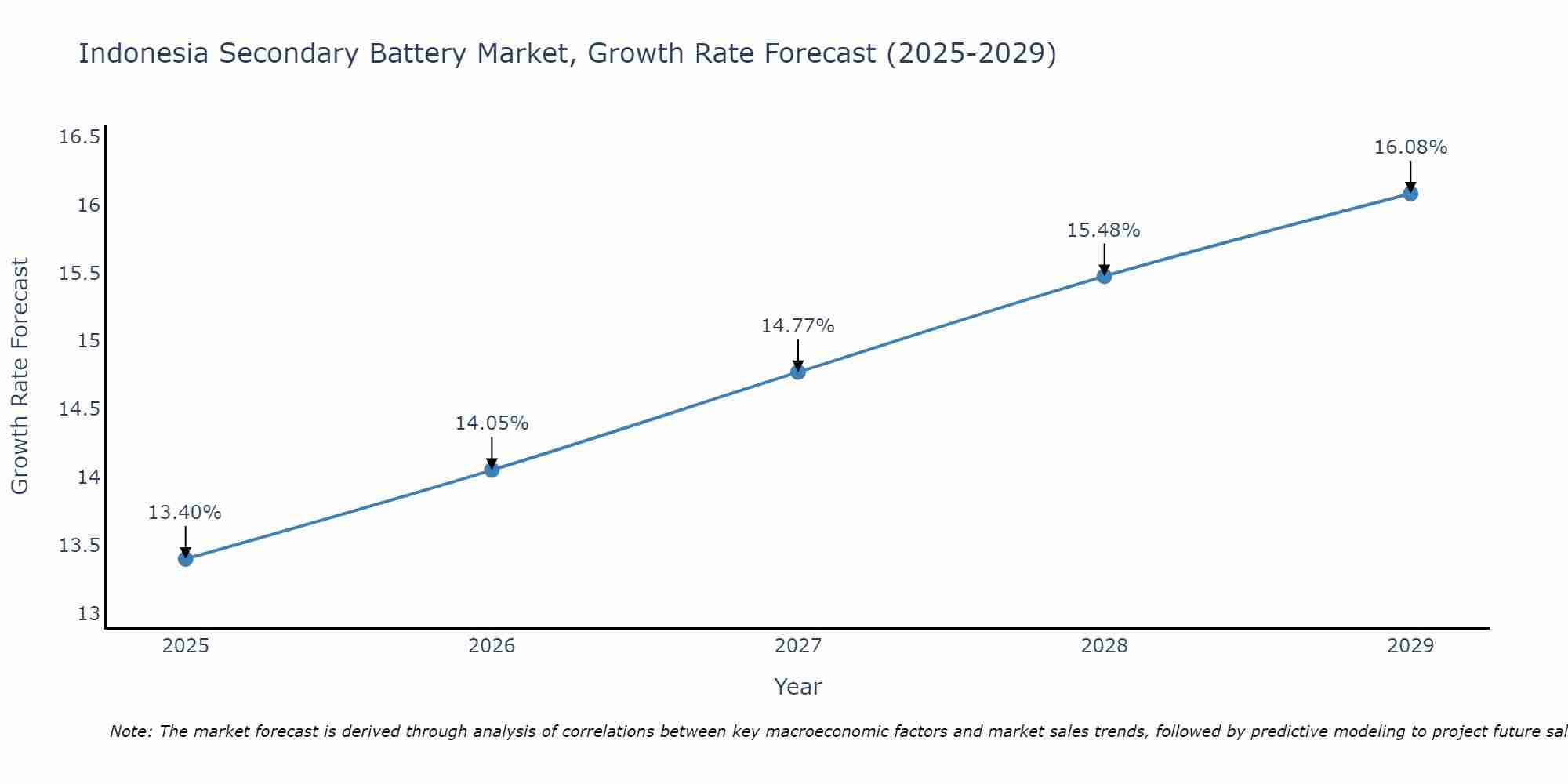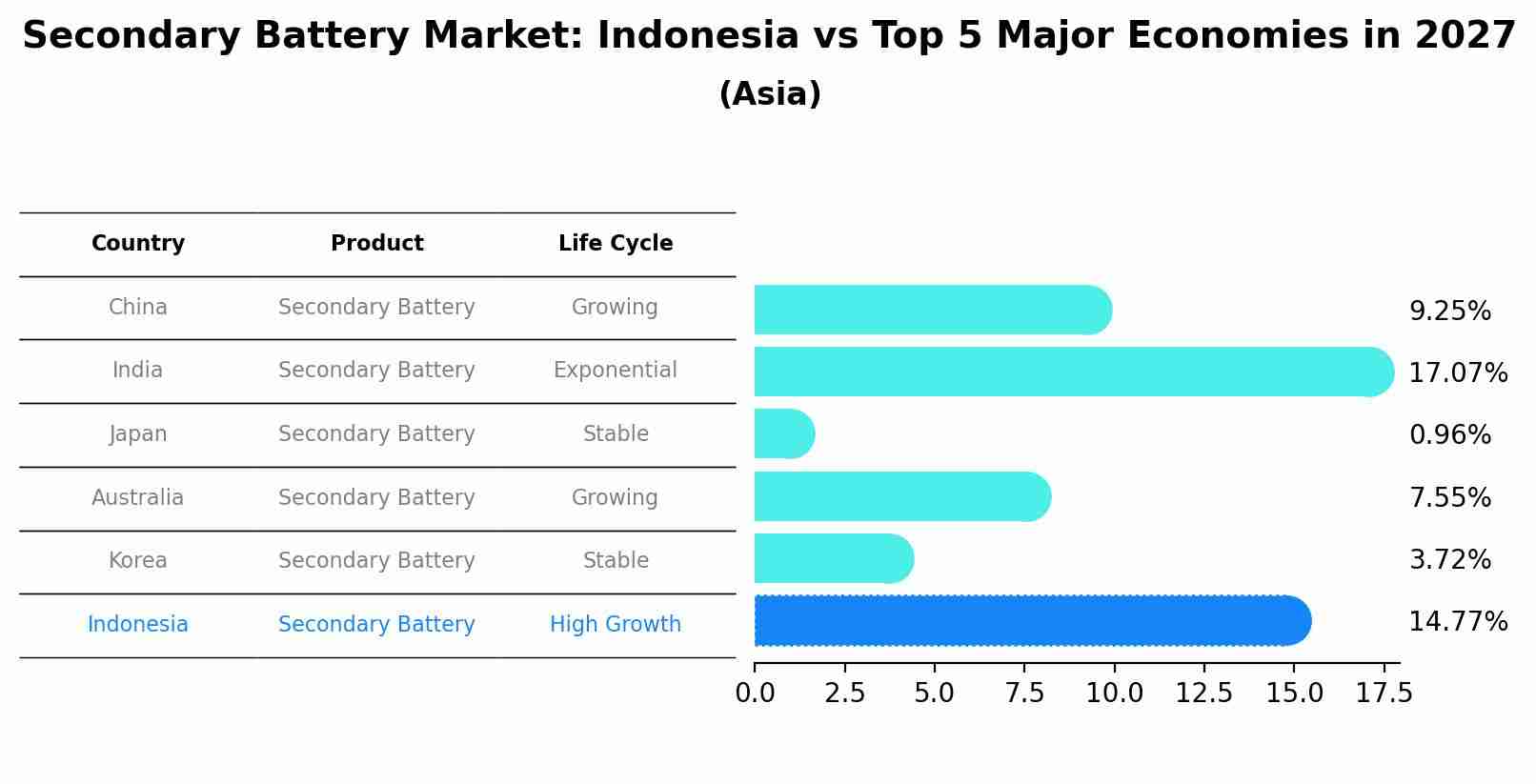Indonesia Secondary Battery Market (2025-2031) Outlook | Share, Growth, Size, Trends, Forecast, Industry, Companies, Revenue, Analysis & Value
| Product Code: ETC270448 | Publication Date: Aug 2023 | Updated Date: Aug 2025 | Product Type: Market Research Report | |
| Publisher: 6Wresearch | No. of Pages: 75 | No. of Figures: 35 | No. of Tables: 20 | |
Indonesia Secondary Battery Market Size Growth Rate
The Indonesia Secondary Battery Market is poised for steady growth rate improvements from 2025 to 2029. The growth rate starts at 13.40% in 2025 and reaches 16.08% by 2029.

Secondary Battery Market: Indonesia vs Top 5 Major Economies in 2027 (Asia)
By 2027, the Secondary Battery market in Indonesia is anticipated to reach a growth rate of 14.77%, as part of an increasingly competitive Asia region, where China remains at the forefront, supported by India, Japan, Australia and South Korea, driving innovations and market adoption across sectors.

Indonesia Secondary Battery Market Synopsis
The Indonesia secondary battery market is estimated to generate revenues worth US$ 1 billion by 2025 owing primarily due to high energy density offered by these batteries compared to its counterparts thus making them suitable for use in portable electronic devices including laptops, cameras and smartphones among others that require higher performance levels when operating under low power conditions while consuming less energy than traditional batteries used earlier. The introduction of innovative product designs integrated into rechargeable Li-ion batteries has also helped drive up their demand significantly leading manufacturers increase production volumes accordingly resulting into an attractive opportunity landscape for stakeholders looking forward invest herein
Drivers of the Market
The Indonesia secondary battery market is being driven by the increasing demand for portable electronics, electric vehicles, and renewable energy storage solutions. As the country focuses on reducing its carbon footprint, the adoption of secondary batteries for energy storage and backup power systems is expected to rise, promoting market growth.
Challenges of the Market
The Indonesia Secondary Battery market faces the challenge of fierce competition among battery manufacturers, both domestic and international. As demand for secondary batteries, such as lithium-ion batteries, continues to grow due to increasing adoption in various industries and applications, manufacturers must constantly innovate and improve their products` performance and energy efficiency to stay ahead in the market. Additionally, ensuring the safety and reliability of these batteries remains a crucial concern, particularly with the rising popularity of electric vehicles and renewable energy storage solutions.
COVID-19 Impact on the Market
The pandemic initially disrupted supply chains and manufacturing operations, leading to production slowdowns and delays in the secondary battery market. However, as remote work and online activities surged, there was a growing demand for electronic devices, which may have boosted the demand for secondary batteries in applications such as laptops, tablets, and smartphones.
Key Highlights of the Report:
- Indonesia Secondary Battery Market Outlook
- Market Size of Indonesia Secondary Battery Market, 2024
- Forecast of Indonesia Secondary Battery Market, 2031
- Historical Data and Forecast of Indonesia Secondary Battery Revenues & Volume for the Period 2021-2031
- Indonesia Secondary Battery Market Trend Evolution
- Indonesia Secondary Battery Market Drivers and Challenges
- Indonesia Secondary Battery Price Trends
- Indonesia Secondary Battery Porter's Five Forces
- Indonesia Secondary Battery Industry Life Cycle
- Historical Data and Forecast of Indonesia Secondary Battery Market Revenues & Volume By Technology for the Period 2021-2031
- Historical Data and Forecast of Indonesia Secondary Battery Market Revenues & Volume By Lead-acid Battery for the Period 2021-2031
- Historical Data and Forecast of Indonesia Secondary Battery Market Revenues & Volume By Lithium-ion Battery for the Period 2021-2031
- Historical Data and Forecast of Indonesia Secondary Battery Market Revenues & Volume By Other Technologies (NiMh, NiCD, etc.) for the Period 2021-2031
- Historical Data and Forecast of Indonesia Secondary Battery Market Revenues & Volume By Application for the Period 2021-2031
- Historical Data and Forecast of Indonesia Secondary Battery Market Revenues & Volume By Automotive Batteries (HEV, PHEV, and EV) for the Period 2021-2031
- Historical Data and Forecast of Indonesia Secondary Battery Market Revenues & Volume By Industrial Batteries (Motive, Stationary (Telecom, UPS, Energy Storage Systems (ESS), etc.) for the Period 2021-2031
- Historical Data and Forecast of Indonesia Secondary Battery Market Revenues & Volume By Portable Batteries (Consumer Electronics, etc.) for the Period 2021-2031
- Historical Data and Forecast of Indonesia Secondary Battery Market Revenues & Volume By Other Applications for the Period 2021-2031
- Indonesia Secondary Battery Import Export Trade Statistics
- Market Opportunity Assessment By Technology
- Market Opportunity Assessment By Application
- Indonesia Secondary Battery Top Companies Market Share
- Indonesia Secondary Battery Competitive Benchmarking By Technical and Operational Parameters
- Indonesia Secondary Battery Company Profiles
- Indonesia Secondary Battery Key Strategic Recommendations
Frequently Asked Questions About the Market Study (FAQs):
1 Executive Summary |
2 Introduction |
2.1 Key Highlights of the Report |
2.2 Report Description |
2.3 Market Scope & Segmentation |
2.4 Research Methodology |
2.5 Assumptions |
3 Indonesia Secondary Battery Market Overview |
3.1 Indonesia Country Macro Economic Indicators |
3.2 Indonesia Secondary Battery Market Revenues & Volume, 2021 & 2031F |
3.3 Indonesia Secondary Battery Market - Industry Life Cycle |
3.4 Indonesia Secondary Battery Market - Porter's Five Forces |
3.5 Indonesia Secondary Battery Market Revenues & Volume Share, By Technology, 2021 & 2031F |
3.6 Indonesia Secondary Battery Market Revenues & Volume Share, By Application, 2021 & 2031F |
4 Indonesia Secondary Battery Market Dynamics |
4.1 Impact Analysis |
4.2 Market Drivers |
4.2.1 Increasing demand for energy storage solutions in Indonesia |
4.2.2 Government initiatives promoting the use of renewable energy sources |
4.2.3 Growth in the automotive industry leading to higher demand for secondary batteries |
4.3 Market Restraints |
4.3.1 Price fluctuations of raw materials used in secondary battery production |
4.3.2 Lack of proper recycling infrastructure for secondary batteries in Indonesia |
4.3.3 Competition from alternative energy storage technologies |
5 Indonesia Secondary Battery Market Trends |
6 Indonesia Secondary Battery Market, By Types |
6.1 Indonesia Secondary Battery Market, By Technology |
6.1.1 Overview and Analysis |
6.1.2 Indonesia Secondary Battery Market Revenues & Volume, By Technology, 2021-2031F |
6.1.3 Indonesia Secondary Battery Market Revenues & Volume, By Lead-acid Battery, 2021-2031F |
6.1.4 Indonesia Secondary Battery Market Revenues & Volume, By Lithium-ion Battery, 2021-2031F |
6.1.5 Indonesia Secondary Battery Market Revenues & Volume, By Other Technologies (NiMh, NiCD, etc.), 2021-2031F |
6.2 Indonesia Secondary Battery Market, By Application |
6.2.1 Overview and Analysis |
6.2.2 Indonesia Secondary Battery Market Revenues & Volume, By Automotive Batteries (HEV, PHEV, and EV), 2021-2031F |
6.2.3 Indonesia Secondary Battery Market Revenues & Volume, By Industrial Batteries (Motive, Stationary (Telecom, UPS, Energy Storage Systems (ESS), etc.), 2021-2031F |
6.2.4 Indonesia Secondary Battery Market Revenues & Volume, By Portable Batteries (Consumer Electronics, etc.), 2021-2031F |
6.2.5 Indonesia Secondary Battery Market Revenues & Volume, By Other Applications, 2021-2031F |
7 Indonesia Secondary Battery Market Import-Export Trade Statistics |
7.1 Indonesia Secondary Battery Market Export to Major Countries |
7.2 Indonesia Secondary Battery Market Imports from Major Countries |
8 Indonesia Secondary Battery Market Key Performance Indicators |
8.1 Adoption rate of secondary batteries in key industries (e.g., automotive, renewable energy) |
8.2 Investment in research and development for improving secondary battery technology |
8.3 Number of partnerships between secondary battery manufacturers and government agencies for sustainable battery disposal and recycling |
8.4 Growth in the number of secondary battery manufacturing facilities in Indonesia |
8.5 Percentage of energy generated from renewable sources that is stored using secondary batteries |
9 Indonesia Secondary Battery Market - Opportunity Assessment |
9.1 Indonesia Secondary Battery Market Opportunity Assessment, By Technology, 2021 & 2031F |
9.2 Indonesia Secondary Battery Market Opportunity Assessment, By Application, 2021 & 2031F |
10 Indonesia Secondary Battery Market - Competitive Landscape |
10.1 Indonesia Secondary Battery Market Revenue Share, By Companies, 2024 |
10.2 Indonesia Secondary Battery Market Competitive Benchmarking, By Operating and Technical Parameters |
11 Company Profiles |
12 Recommendations |
13 Disclaimer |
- Single User License$ 1,995
- Department License$ 2,400
- Site License$ 3,120
- Global License$ 3,795
Search
Related Reports
- Saudi Arabia Manlift Market (2025-2031) | Outlook, Size, Growth, Trends, Companies, Industry, Revenue, Value, Share, Forecast & Analysis
- Uganda Excavator, Crane, and Wheel Loaders Market (2025-2031) | Strategy, Consumer Insights, Analysis, Investment Trends, Opportunities, Growth, Size, Share, Industry, Revenue, Segments, Value, Segmentation, Supply, Forecast, Restraints, Outlook, Competition, Drivers, Trends, Demand, Pricing Analysis, Competitive, Strategic Insights, Companies, Challenges
- Rwanda Excavator, Crane, and Wheel Loaders Market (2025-2031) | Strategy, Consumer Insights, Analysis, Investment Trends, Opportunities, Growth, Size, Share, Industry, Revenue, Segments, Value, Segmentation, Supply, Forecast, Restraints, Outlook, Competition, Drivers, Trends, Demand, Pricing Analysis, Competitive, Strategic Insights, Companies, Challenges
- Kenya Excavator, Crane, and Wheel Loaders Market (2025-2031) | Strategy, Consumer Insights, Analysis, Investment Trends, Opportunities, Growth, Size, Share, Industry, Revenue, Segments, Value, Segmentation, Supply, Forecast, Restraints, Outlook, Competition, Drivers, Trends, Demand, Pricing Analysis, Competitive, Strategic Insights, Companies, Challenges
- Angola Excavator, Crane, and Wheel Loaders Market (2025-2031) | Strategy, Consumer Insights, Analysis, Investment Trends, Opportunities, Growth, Size, Share, Industry, Revenue, Segments, Value, Segmentation, Supply, Forecast, Restraints, Outlook, Competition, Drivers, Trends, Demand, Pricing Analysis, Competitive, Strategic Insights, Companies, Challenges
- Israel Intelligent Transport System Market (2025-2031) | Strategy, Consumer Insights, Analysis, Investment Trends, Opportunities, Growth, Size, Share, Industry, Revenue, Segments, Value, Segmentation, Supply, Forecast, Restraints, Outlook, Competition, Drivers, Trends, Demand, Pricing Analysis, Competitive, Strategic Insights, Companies, Challenges
- Uganda Precast and Aggregate Market (2025-2031) | Strategy, Consumer Insights, Analysis, Investment Trends, Opportunities, Growth, Size, Share, Industry, Revenue, Segments, Value, Segmentation, Supply, Forecast, Restraints, Outlook, Competition, Drivers, Trends, Demand, Pricing Analysis, Competitive, Strategic Insights, Companies, Challenges
- Australia IT Asset Disposal Market (2025-2031) | Strategy, Consumer Insights, Analysis, Investment Trends, Opportunities, Growth, Size, Share, Industry, Revenue, Segments, Value, Segmentation, Supply, Forecast, Restraints, Outlook, Competition, Drivers, Trends, Demand, Pricing Analysis, Competitive, Strategic Insights, Companies, Challenges
- UAE Building Thermal Insulation Market Outlook (2025-2031) | Revenue, Companies, Share, Trends, Growth, Size, Forecast, Industry, Analysis & Value
- Portugal Electronic Document Management Market (2025-2031) | Strategy, Consumer Insights, Analysis, Investment Trends, Opportunities, Growth, Size, Share, Industry, Revenue, Segments, Value, Segmentation, Supply, Forecast, Restraints, Outlook, Competition, Drivers, Trends, Demand, Pricing Analysis, Competitive, Strategic Insights, Companies, Challenges
Industry Events and Analyst Meet
Our Clients
Whitepaper
- Middle East & Africa Commercial Security Market Click here to view more.
- Middle East & Africa Fire Safety Systems & Equipment Market Click here to view more.
- GCC Drone Market Click here to view more.
- Middle East Lighting Fixture Market Click here to view more.
- GCC Physical & Perimeter Security Market Click here to view more.
6WResearch In News
- Doha a strategic location for EV manufacturing hub: IPA Qatar
- Demand for luxury TVs surging in the GCC, says Samsung
- Empowering Growth: The Thriving Journey of Bangladesh’s Cable Industry
- Demand for luxury TVs surging in the GCC, says Samsung
- Video call with a traditional healer? Once unthinkable, it’s now common in South Africa
- Intelligent Buildings To Smooth GCC’s Path To Net Zero













